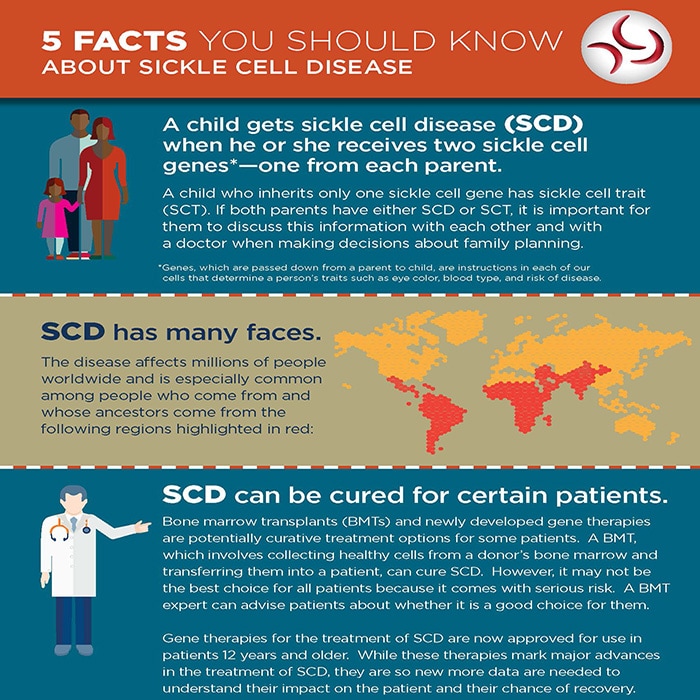Key points
- Sickle cell disease (SCD) is a group of inherited blood disorders. Abnormal hemoglobin is produced.
- Red blood cells become hard and sticky and get stuck in small blood vessels, resulting in pain and other serious complications.
- There are several types of SCD, some more severe than others.
- In the United States, SCD is often found at birth through routine newborn screening.

Overview
Sickle cell disease (SCD) is a group of inherited red blood cell disorders. Red blood cells contain hemoglobin, a protein that carries oxygen. Healthy red blood cells are round, and they move through small blood vessels to carry oxygen to all parts of the body.
In someone who has SCD, the hemoglobin is abnormal, which causes the red blood cells to become hard and sticky and look like a C-shaped farm tool called a sickle. The sickle cells die early, which causes a constant shortage of red blood cells. Also, when they travel through small blood vessels, sickle cells get stuck and clog the blood flow. This can cause pain and other serious complications (health problems) such as infection, acute chest syndrome, and stroke.
Types
There are several types of SCD. The specific type of SCD a person has depends on the genes they inherited from their parents. People with SCD inherit genes that contain instructions, or code, for abnormal hemoglobin.
Below are the most common types of SCD:
HbSS
People who have this form of SCD inherit two genes, one from each parent, that code for hemoglobin "S." Hemoglobin S is an abnormal form of hemoglobin that causes the red cells to become rigid, and sickle shaped. This is commonly called sickle cell anemia and is usually the most severe form of the disease.
HbSC
People who have this form of SCD inherit a hemoglobin S gene from one parent and a gene for a different type of abnormal hemoglobin called "C" from the other parent. This is usually a milder form of SCD.
HbS beta thalassemia
People who have this form of SCD inherit a hemoglobin S gene from one parent and a gene for beta thalassemia, another type of hemoglobin abnormality, from the other parent. There are two types of beta thalassemia: "zero" (HbS beta0) and "plus" (HbS beta+). Those with HbS beta0-thalassemia usually have a severe form of SCD. People with HbS beta+-thalassemia tend to have a milder form of SCD.
There also are a few rare types of SCD, such as the following:
HbSD, HbSE, and HbSO
People who have these forms of SCD inherit one hemoglobin S gene and one gene that codes for another abnormal type of hemoglobin ("D," "E," or "O"). The severity of these rarer types of SCD varies.
Sickle cell trait (SCT)
HbAS
People who have sickle cell trait (SCT) inherit a hemoglobin S gene from one parent and a normal gene (one that codes for hemoglobin "A") from the other parent. People with SCT usually do not have any of the signs of the disease. However, in rare cases, a person with SCT may develop health problems; this occurs most often when there are other stresses on the body, such as when a person becomes dehydrated or exercises strenuously. Additionally, people who have SCT can pass the abnormal hemoglobin S gene on to their children.
Causes
SCD is a genetic condition that is present at birth. It is inherited when a child receives two genes—one from each parent—that code for abnormal hemoglobin.
Diagnosis
SCD is diagnosed with a simple blood test. In children born in the United States, it most often is found at birth during routine newborn screening tests at the hospital. In addition, SCD can be diagnosed while the baby is in the womb. Diagnostic tests before the baby is born, such as chorionic villus sampling and amniocentesis, can check for chromosomal or genetic abnormalities in the baby. Chorionic villus sampling tests a tiny piece of the placenta called chorionic villus. Amniocentesis tests a small sample of amniotic fluid surrounding the baby.
Because children with SCD are at an increased risk of infection and other health problems, early diagnosis and treatment are important.
Talk to your doctor to find out how to get tested and to learn about the results after testing.
Complications
People with SCD may start to have signs of the disease during the first year of life, usually around 5 months of age. Symptoms and complications of SCD are different for each person and can range from mild to severe.
Prevention and treatment of SCD complications
Management of SCD is focused on preventing and treating pain episodes and complications. Prevention strategies include lifestyle behaviors such as maintaining adequate fluid intake and avoiding extreme temperatures and medical screenings such as transcranial Doppler (TCD) ultrasound screenings to identify children at increased risk of stroke.
Prevention measures also include medical interventions such as vaccines to prevent infections and blood transfusions to reduce the occurrence of stroke in persons identified to be at risk. When pain crises occur, they can be managed through various clinical strategies include medication and intravenous fluids. Additionally, several medications are available that can be taken regularly to prevent or reduce the occurrence of pain crises and other complications. Bone marrow transplants and newly developed gene therapies are also potential treatment options for some patients.
Resources
Below is a list of resources and key organizations of interest to people living with SCD and their families.
American Society of Hematology
- SCD Initiative: An initiative to improve outcomes for people with SCD
- Build Your Own SCD School Binder: Resources to support students with SCD
American College of Emergency Physician's Emergency Department Sickle Cell Care Coalition
Information about emergency care for people with SCD
Children's Hospital of Philadelphia Sickle Cell Center
Sickle cell school outreach tools and educational resources
ClinicalTrials.gov
Up-to-date information on sickle cell disease clinical research trials
Foundation for Women & Girls+ with Blood Disorders (FWGBD)
An organization dedicated to ensuring all women and girls with blood disorders are correctly diagnosed and optimally treated and managed at every stage of life
Health Resources and Services Administration
- A Guide to College Transition for Sickle Cell Warriors: A guide for sickle cell warriors who are planning to attend college.
National Heart, Lung, and Blood Institute
Sickle cell information, tips for healthy living, and resources
National Human Resource Genome Institute
Gene therapy education materials for the sickle cell disease community
Sickle Cell Disease Association of America
Information, news, research, and resources
Sickle Cell Information Center
Information about SCD; resources for patients, families, and healthcare providers; research; clinical trials; news; and books
Sickle Cell Reproductive Health Education Directive
Resources on reproductive health care for people living with all types of SCD
Social Security Administration's Sickle Cell Disease and the Social Security Disability Evaluation Process for Adults
Learn about the disability application and evaluation process, including tips and examples, for adults with SCD.
U.S. Department of Education's Section 504 Protections for Students with Sickle Cell Disease Fact Sheet
Information from the U.S. Department of Education on Section 504 of the Rehabilitation Act of 1973, a Federal civil rights law that protects students from disability-based discrimination in schools that receive Federal financial assistance
U.S. Department of Health and Human Services' Head Start Early Childhood Learning & Knowledge Center's Article on Caring for Young Children Living with Sickle Cell Disease
Tips and information for Head Start staff and other early childhood program staff who care for a child with SCD

